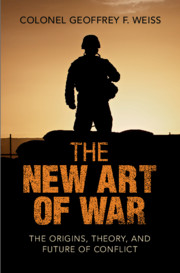Book contents
- The New Art of War
- The New Art of War
- Copyright page
- Dedication
- Contents
- Figures
- Preface
- Acknowledgments
- Introduction: Why Study War?
- 1 The Origins of War
- 2 The Masters of War Theory and Strategy
- 3 Small Wars and Domain Theory
- 4 The Unified War Theory
- 5 The Future of War
- Conclusion
- Appendix
- Notes
- Bibliography
- Index
Introduction: Why Study War?
Published online by Cambridge University Press: 12 August 2021
- The New Art of War
- The New Art of War
- Copyright page
- Dedication
- Contents
- Figures
- Preface
- Acknowledgments
- Introduction: Why Study War?
- 1 The Origins of War
- 2 The Masters of War Theory and Strategy
- 3 Small Wars and Domain Theory
- 4 The Unified War Theory
- 5 The Future of War
- Conclusion
- Appendix
- Notes
- Bibliography
- Index
Summary
The Introduction argues that war’s danger, nuances, complexity, and impact on humanity demand further study, despite our seeming reluctance to do so. It contends that war is rife with contradictions which call out for further examination. For example, war evokes humanity’s worst traits, including vengeance, treachery, and hatred, and it has claimed millions of lives, spawned atrocities, and caused massive destruction. Yet, war has also inspired courage, honor, sacrifice, and loyalty, deposed tyrants, led to larger, more peaceful civilizations, and produced remarkable innovations that protect and preserve life. The introduction concludes by recommending that war’s repulsiveness and complexity should inspire, not deter, scholarly attention, for as with any dangerous phenomenon, understanding war’s nature is the best way to gain enough control over it to prevent wars and to diminish their hazards and prevalence.
- Type
- Chapter
- Information
- The New Art of WarThe Origins, Theory, and Future of Conflict, pp. 1 - 5Publisher: Cambridge University PressPrint publication year: 2021

